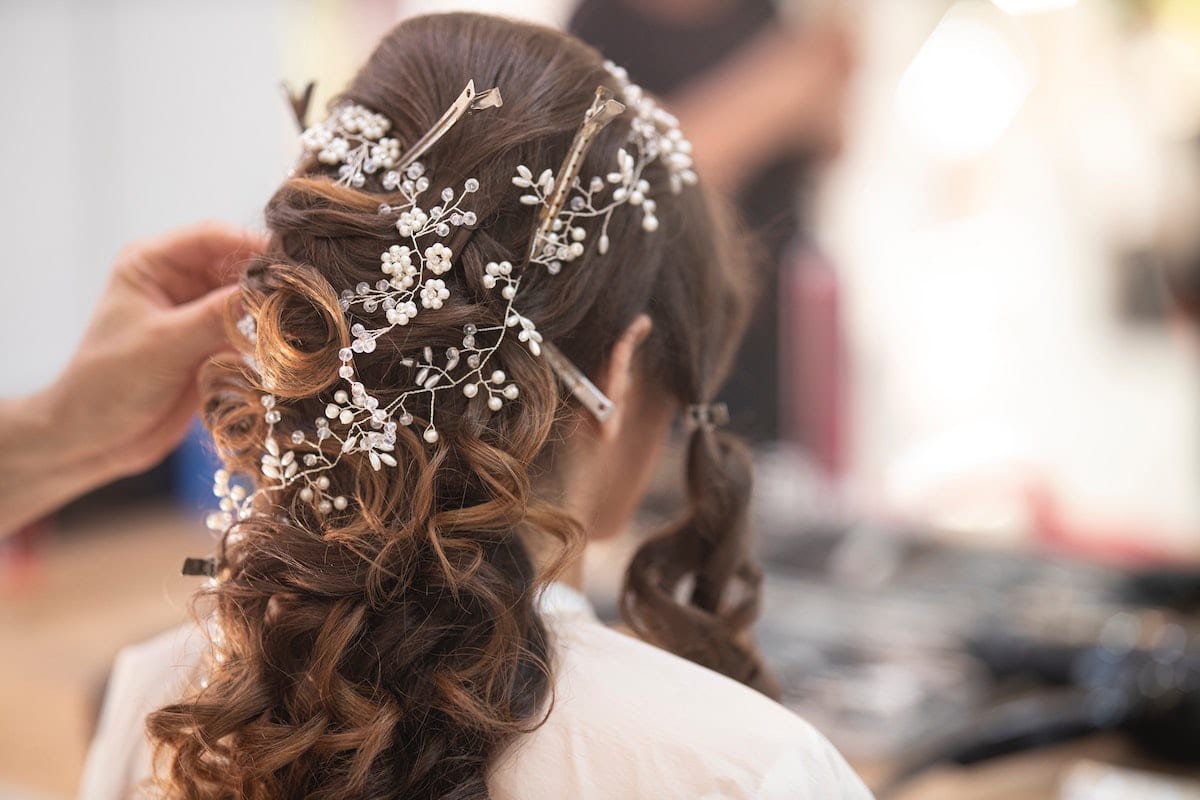By Pauline Weston Thomas for Fashion-Era.com

Beauty is Shape
- The Fashion Silhouette
- Body Image
- Cosmetic Surgery
- Body and Breast Enhancement
- Bernard Rudofsky
- Head Flattening, Elongation and Lip Stretching
- Obesity and Emaciation
- C18thGeorgian Deception
- Georgian Wig Vanity
- Foot Binding
- Marilyn Monroe
- 20th Century Modern Shoes
- Corset Restrictions
Body Image
This page looks at how different societies view the body silhouette, the body image as ugly or beautiful. It examines some of the ways individuals have manipulated their body image, to gain the cultural ideal of an era.
Fashion history shows the most desirable body image of a fashion era is most often achieved by distorting the figure by enlargement or reduction, or by flattening or moving parts into new positions.
The Fashion Silhouette
Fashion is a shape, a changing shape. That shape is mainly formed and controlled by some device which affects part of the body's natural outline. What is considered beautiful in the eyes of one race may be thought horrific in another. Beauty then is in the eye of the beholder, and for centuries beauty has been shape.
Cosmetic Surgery
In the Western world the outlines of women's bodies have been controlled by corsetry and petticoat constructions. But now many consumers have their figure faults corrected by cosmetic surgery with implants or liposuction fat reduction. Plastic surgery was originally developed thousands of years ago in India for treating injuries and birth defects. Then just over a century ago in 1885 when local anaesthetics were invented, surgeons began performing various cosmetic operations.
In 1901 the first face lift was done by Eugene Hollander of Berlin. The wealthy liked face lifts. A face lift meant they could actually buy some youth, even though the body cells were ageing.
Body and Breast Enhancement
Body image can be adapted to accommodate changing fashions. In the 1920s some women endured breast reductions so they could wear the flat boyish fashions.
By the 1930s the breast in all its glory was soon back in fashion. The fuller the bosom the better. Expensive surgical enlargement was often done for people such as actresses but was not talked about much. More recently the silhouette from various angles has been manipulated even more by cosmetic surgery.
Nowadays people with ordinary incomes view breast enlargement as their right to satisfy emotional and fashionable needs.
People of every age group have become obsessed by their body image. Older teenage girls particularly favour breast implants. Liposuction, tummy tucks, nose jobs, lip manipulation and implants for fuller breasts have all become popular in search of the ideal silhouette.
Bernard Rudofsky
In 1944 Bernard Rudofsky worked at the Museum of Modern Art in New York where he was Director of Apparel Research.
He designed silhouette figures that were sculpted by Nivola for the MOMA exhibition called 'Are Clothes Modern'.
The shapes belonged to different periods of Western fashion and corresponded to the shape that supported top clothes.
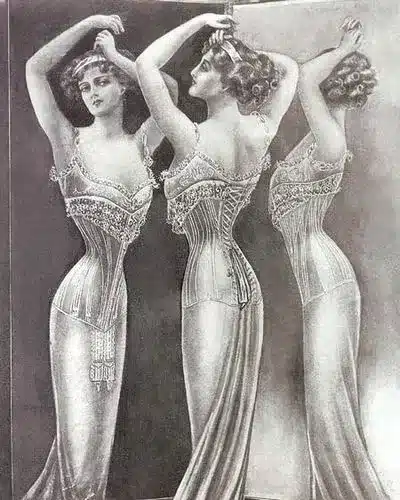
Head Flattening, Elongation and Lip Stretching
Moulding of the skull and the practice of head flattening was common among Mayan society and has been used in Eastern countries. Protuberances such as the nose, ears and forehead were flattened to conform to the cultural beauty ideal.
The head was flattened by putting the newborn infant's head between two wooden boards creating a mouse trap like cradle, held in place with bindings. The soft skull slowly moulded to the cultural beauty ideal of flatness and after a few years, the boards were removed permanently.
Elongated heads have been as popular as flattened heads. A Congo woman with an elongated head would be thought very beautiful by her people.
Similarly, a Chad woman would have had her lips supported and stretched by metal rings since early childhood. In adulthood, her stretched lips would express the ultimate in beauty. Western society has not gone quite this far, but it is now fashionable for some women to have collagen injections and implants to enlarge the lips.
Extremes include plastic surgery where the lips are turned inside out and although some find this an attractive feature on a woman, many do not and are repulsed by it.
Obesity and Emaciation
Primitive peoples still gauge female beauty by sheer bulk and brides-to-be go through excessive fattening. Hottentot women are celebrated examples of women with excessive fat deposits in the buttocks.
In contrast, western brides go through an equally gruelling slimming regime to achieve a sylph like figure forever commemorated by wedding photographs and video film.
Emaciation has now become the ultimate symbol of achievement and affluence.
C18thGeorgian Deception
The women of Georgian high society looked beautiful in their satins and silks, but they hardly ever bathed. Sanitation was still quite crude and they preferred to douse their clothes, their bodies and their belongings in toilet water and perfumes.
They wore scented pomanders and carried small scent bottles about their person. They had false teeth, false hair, false bosoms, false calves and induced large eyes which they made to falsely dilate by using Belladonna extracted from the Deadly Nightshade plant. They were a walking deception.
Earlier in the 1600s, patches had been used to cover smallpox scars and the fashion lasted well into the 18th Century. The patches were small plain dots of black taffeta or velvet and the shapes developed into various symbols such as stars and moons. These were then gummed to the scars.
Georgian Wig Vanity
During the 18th century, hairstyles for women began with simplicity. Women added a few false curls only if their own hair was inadequate. But after 1760 the demand for false hair in Britain reached a climax. The fashion for French hairstyles grew as fast as the size of the enormous styles.
It took hours to dress the hair so high and women expected the style to last for a minimum of a week, preferably longer. Since hygiene was poor, lice in the hair and persistent headaches caused by the dragging weight, became an acceptable fact of life.

Women often slept sitting up to keep the style in place and scratched their itching scalps using the misnamed long handled backscratchers of today. These were carved from ivory or made of silver or combinations of Mother of Pearl. This vanity has often been recorded in contemporary cartoons.
Hair was initially built up over horsehair and wool padded frames beginning with the natural hair. Then vast amounts of false hair was added, sometimes building the hair up to reach 30 inches. This was about half the height of the average female of the day. Hair was worn so high that the chin was halfway between the top of the head and the feet. Frequently ladies would have difficulty getting through doors and riding in carriages.
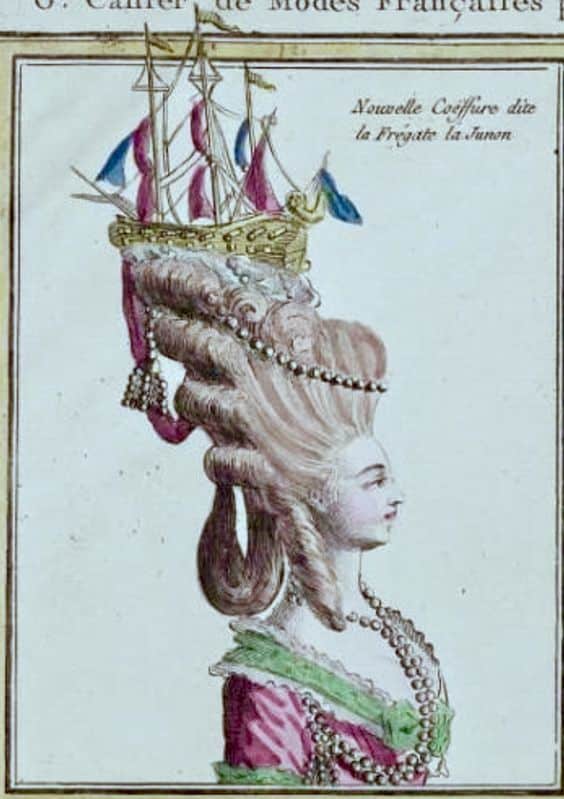
Women had to be careful in ballrooms not to get their hairstyle caught in the candlelit chandeliers.
More than one head of hair went up in flames and the roof of St. Paul's Cathedral in London had to be raised four feet in 1776 so that the gentry could enter without mishap to their coiffures.
These flamboyant hairstyles were often topped by scenes depicting farmyards or ships or floral and jewel ornamentation. Frequently they were finished off with lavish wide-brimmed hats later known as Gainsborough hats.
Foot Binding
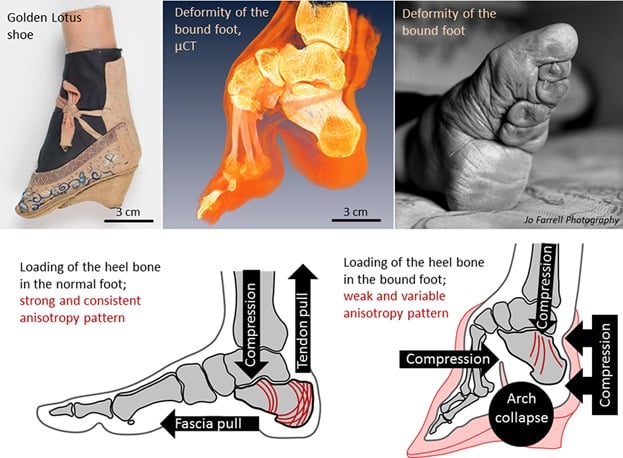
Until about a hundred years ago a small dainty foot was considered essential to make a Chinese woman eligible for marriage. Small feet are a racial characteristic of Chinese women. The desire to make the foot smaller in the name of beauty was strong enough for the Chinese to mutilate female feet for nearly 1000 years.
The feet were cut and bound tightly with cloth. The main purpose of foot binding was to introduced an organically grown heel which made the woman hobble when she walked. Her desirability as a love object was in direct proportion to her inability to walk.
The smallest female feet to be found in the UK today are in Pontypridd in South Wales, UK, where women there often have feet UK sized 2 or 3.
Marilyn Monroe
The 20th century film icon Marylyn Monroe deliberately had the stiletto heels of her shoes adjusted. One heel was made shorter than the other so that she swayed and sashayed as she walked. Her swaying hips helped make her appear more vulnerable, increasing her sexual appeal
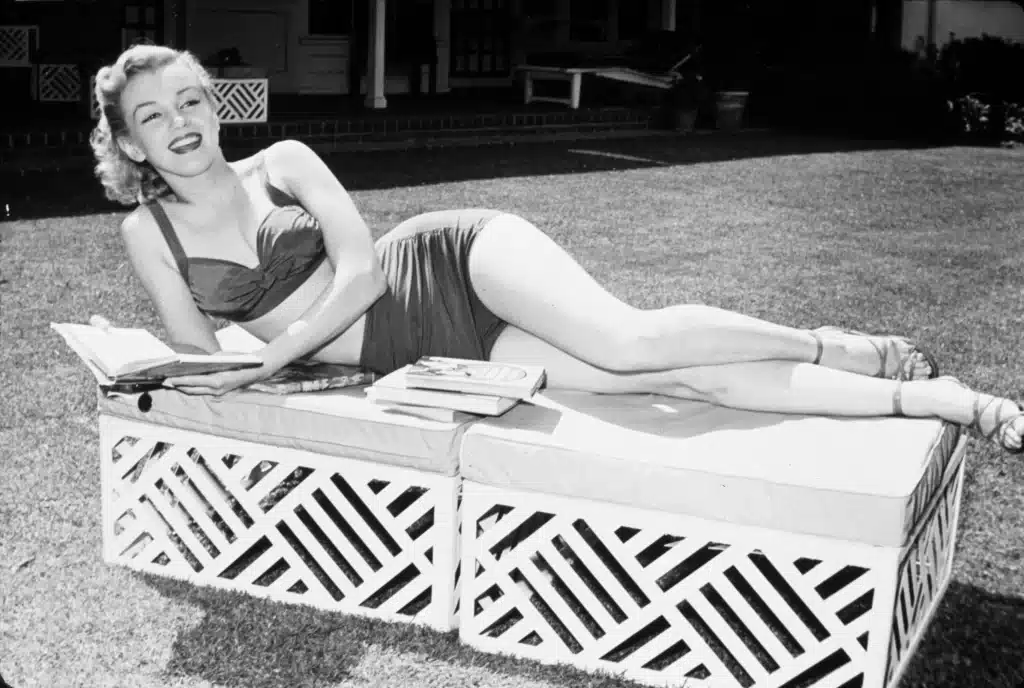
Marilyn Monroe - Her perfect natural hourglass body was perfect for the 1950s where womanly curves made for the desirable body image of the fashion era.
Her body ideal would today be considered too heavy for today's icons of beauty.
20th-Century Modern Shoes
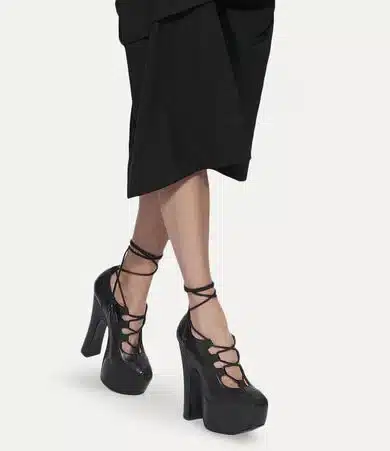
Although foot binding seems cruel in the 21st century, modern shoes frequently deform the foot. Shoe lasts often show an evenly pointed shape around which modern shoes are built.
The foot that fits the shoe made from a pointed last should have its big toe in the middle, flanked by two smaller toes on either side. Platform shoes that elongate the leg, but place the wearer in danger of ankle twisting, have come in and out of fashion several times in the last fifty years.
left: A platform shoe by Vivienne Westwood.
In the 1990s a famous incident occurred with platform soles, when Naomi Campbell slipped during Vivienne Westwood's fashion show whilst Miss Campbell was wearing very high platform shoes.
Corset Restrictions
One of the greatest restrictions placed on women has been corsetry. Severe lacing restricts movement and can damage internal organs and impair health. Female emancipators of the early 20th century used pictures which showed the position of the female internal organs with and without corsetry.
Pictures of deformed rib cages were also used illustrate how breathing was impaired. They used the evidence to support their arguments for condemning the corset.
There is considerable thought that such images of wasp waist were enhanced by artistic licence.
Small waists did exist, but were usually on young girls and needed 'training'.
Today when women take to corsets it can take about 2 years to achieve a gradually smaller waist using lacing methods.
Goths are very fond of corsets in their fashion style.
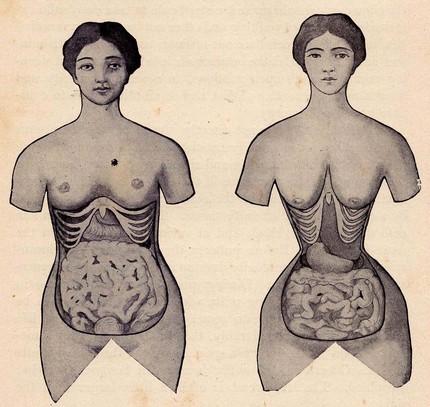
Typical images used in medical books and suggested a woman's internal organs before and after restraining in tight corsetry in the Victorian era. Please note that even the Victorians were capable of manipulating pictures to their own end if it served a purpose.
Recent medical examinations of females corseted today in actual Victorian corsets show how the women had no energy and lacked breath when given lung tests. Once the corset was undone the women felt energised again.
The test is not a fair test as women did not simply lace immediately to a 16-inch waist, they trained the waist over a period of years. Over 2 years a 22-inch waist can be gradually reduced to a handspan by gradual increments of the lacing. It would take about a year of not wearing a corset for the internal organs to settle back to the natural position. But back they would go.
First Corsets
Corseting has existed for thousands of years. The first recorded corset came from Crete. The Cretan woman stands proudly bare-breasted and the corset is obviously a decorative part of her underwear. Madonna's imagery and use of bustiers is not new, it is merely a revived fashion which has had mass media coverage and so become universally adopted.
However, she was astute enough and clever enough to put the style across in the 1980s and make it her own in the 20th century.
Corsetry and body contouring is so important to fashion that we have a whole section devoted to undergarment history.

